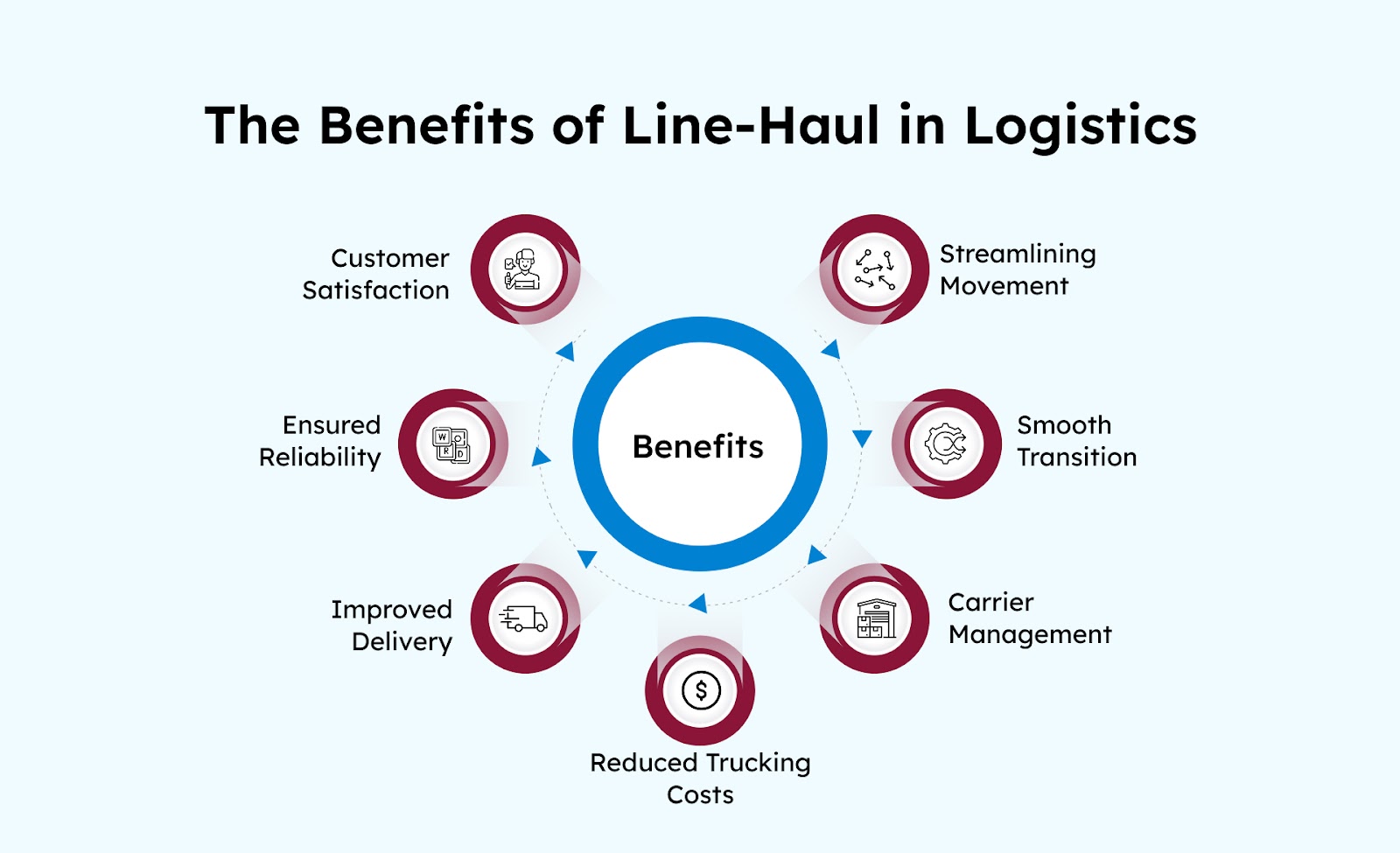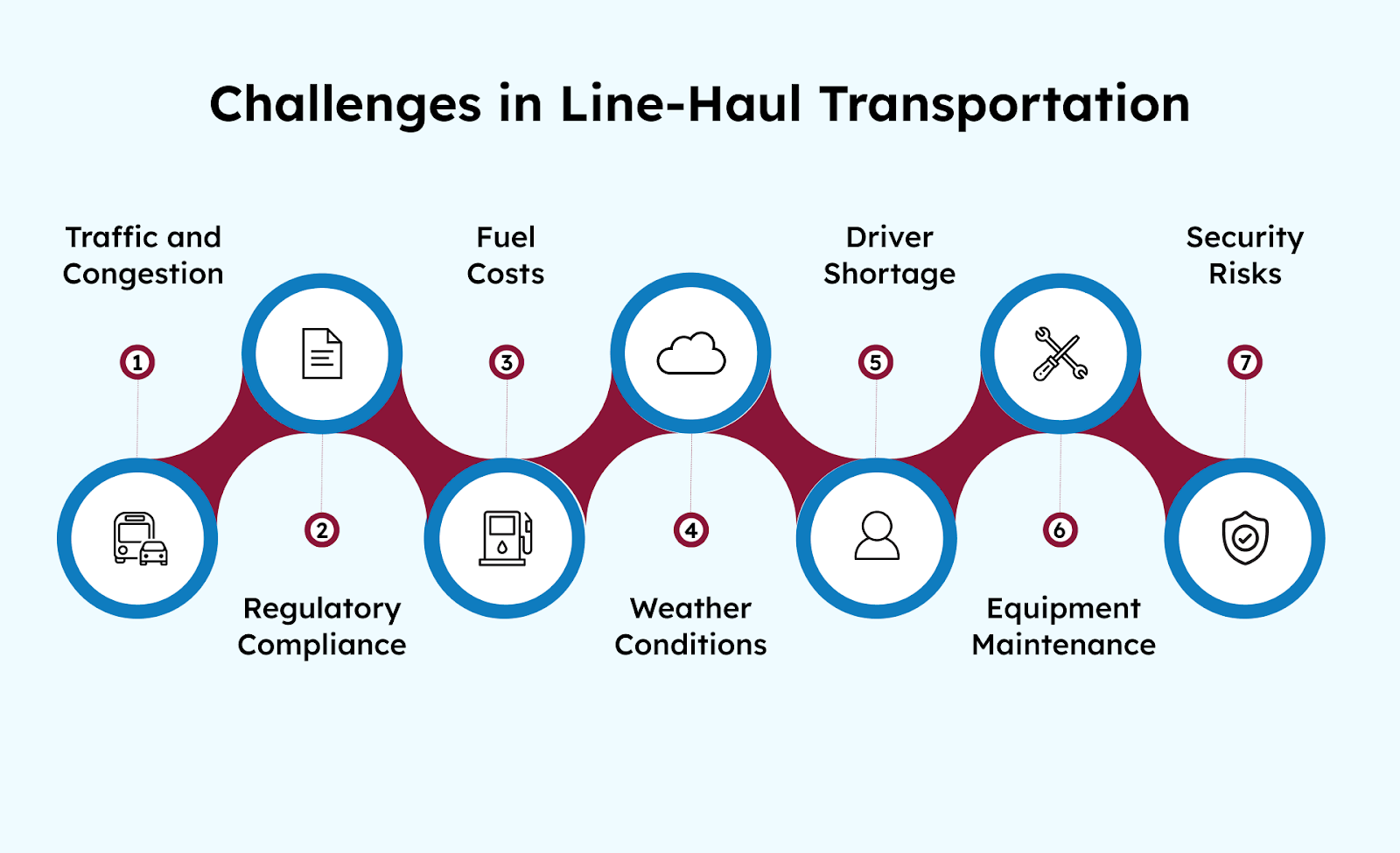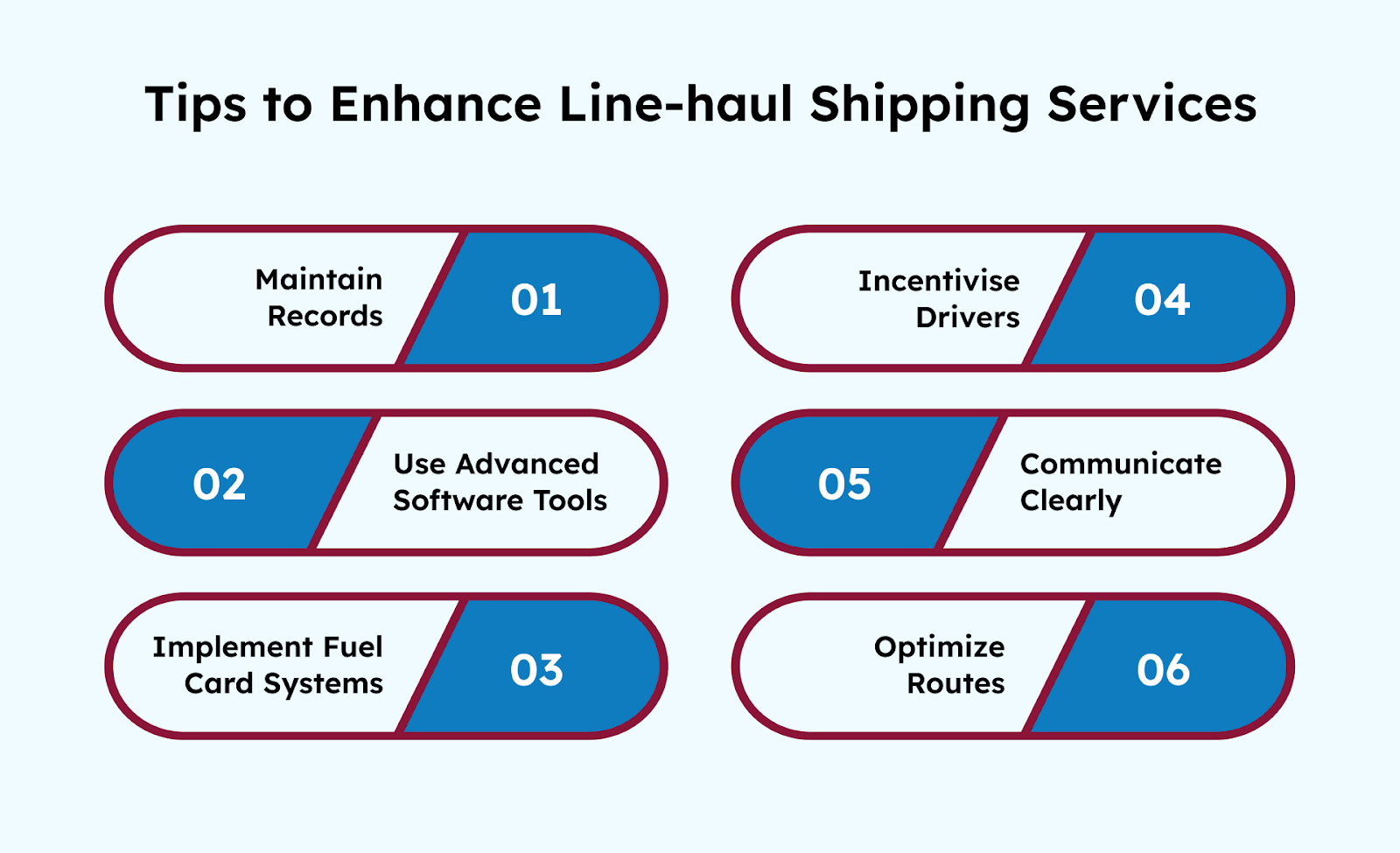Line-haul transportation is a critical component of the freight industry, responsible for moving goods over long distances between major cities and regions. It ensures that products reach their destinations efficiently, supporting businesses and consumers alike with timely deliveries.
This blog will provide a clear understanding of line-haul transportation, covering the key concepts, its role in the logistics industry, the benefits it offers businesses, and the challenges involved.
What is Line-Haul Transportation?
Line-haul transportation refers to the long-distance movement of goods between two predetermined points, typically between distribution centres, warehouses, or major transportation hubs.
It’s the key part of the supply chain that ensures products travel over great distances efficiently, connecting manufacturers, retailers, and ultimately customers. This type of transportation is crucial for businesses looking to maintain a smooth flow of goods across cities, regions, or even countries.
Who Needs Line-Haul Services?
Line-haul plays a crucial role across various industries:
- eCommerce Businesses: Move goods between warehouses and sorting facilities, ensuring timely last-mile deliveries.
- Manufacturers: Transport raw materials and finished goods, optimising inventory and speeding up production.
- Retailers: Move stock between locations, especially during peak seasons, to maintain inventory levels.
- Logistics Providers (3PLs): Relies on line-haul for long-distance transport, offering full logistics solutions.
- International Traders: Facilitates cross-border shipments, helping expand into new markets.
- Niche Markets: Supports industries like perishable goods or hazardous materials with specialised equipment.
Line-haul transportation is essential for businesses across various sectors, offering both flexibility and cost-effective solutions for long-distance freight movement.
Also Read: Contract Logistics vs 3PL: Key Differences and Benefits
What is a Line Haul Carrier?
Line haul carriers are companies or services in the logistics network, responsible for managing the long-distance movement of goods between cities, distribution centres, and sorting facilities. These carriers handle complex operations, often moving freight across multiple transportation modes and locations.
Key Areas a Line Haul Carrier Impacts
- Freight Movement Between Cities: Line haul carriers are responsible for efficiently transporting goods between different regions, ensuring products travel seamlessly over long distances.
- Delivery Timelines: Carriers play a significant role in meeting delivery schedules, ensuring shipments reach their destinations on time, especially for time-sensitive goods.
- Depot and Sorting Facility Transfers: They handle the transfer of goods to and from various depots and sorting facilities, helping streamline the flow of freight and ensuring products are in the right place at the right time.
- Transportation Costs: The efficiency of line haul carriers directly affects transportation costs, making it crucial to select carriers that offer a balance of speed, reliability, and cost-effectiveness.
By choosing a skilled line haul carrier, businesses can optimise their supply chain, reduce delays, and maintain high standards of service across their entire logistics operation.
Now that we’ve covered the basics, let’s understand the key components of line-haul transportation.
Key Components of Line-Haul Transportation

Line-haul transportation is a complex operation comprising several key components that work together to ensure goods move efficiently over long distances. Understanding these elements is crucial for maximising the effectiveness of line-haul services.
1. Equipment
The equipment used in line-haul is critical to the smooth movement of goods. The main vehicles used are heavy-duty trucks, but there are various types of trailers tailored for specific cargo needs:
- Flatbed Trailers: Designed for large, oddly shaped items that cannot be easily loaded into a standard trailer.
- Dry Vans: Standard enclosed trailers used for general cargo that doesn’t require temperature control.
- Reefer Trailers: These are refrigerated trailers, essential for transporting perishable goods that must be kept at a specific temperature.
- Intermodal Containers: For added flexibility, these containers can be transferred easily between trucks, trains, and ships, allowing for smoother long-distance transportation.
WareOne connects you with reliable carriers, ensuring smooth logistics from start to finish. Whether it's warehousing or transportation, we offer flexible, on-demand solutions tailored to your business needs.
Also Read: Exploring On-Demand Logistics: Impact and Evolution
2. Routes and Scheduling
A well-planned route and schedule are vital to the success of line-haul transportation. Factors such as traffic, weather, and road conditions are considered to minimise delays. The following are the key elements of this component:
- Route Optimisation: Routes are designed to be as direct as possible while avoiding areas prone to congestion or delays.
- Timely Scheduling: Once a route is set, adhering to strict schedules ensures goods are delivered on time and the supply chain remains intact.
3. Network Design
The design of the network connecting different points in the supply chain is crucial for ensuring the smooth flow of goods. Here’s what a robust network includes:
- Origin and Destination Points: These locations are where cargo is picked up and delivered, respectively.
- Intermodal Hubs: These hubs allow goods to be transferred between different transportation modes (e.g., from trucks to trains or ships), providing flexibility and efficiency in moving goods across regions.
- Strategic Placement: Proper network design ensures that locations are well-placed for maximum coverage and the efficient transfer of goods.
Each component plays a critical role in ensuring that line-haul transportation is effective and efficient, contributing to the smooth movement of goods across vast distances.
Types of Line-Haul Transportation
Line-haul transportation can involve multiple modes of transport, depending on the route and the nature of the cargo. Below is an overview of the most common transportation options used in line-haul services:
These modes of transportation work together to move freight from one point to another, ensuring goods are consolidated and transported most efficiently. Line-haul carriers typically handle the pick-up and drop-off of cargo, with goods often transferred at key hubs or sorting facilities along the way.
Looking to enhance your logistics operations? WareOne offers flexible, on-demand transportation solutions that ensure efficient, cost-effective delivery. Learn more about our transportation services and optimise your supply chain today.
The Benefits of Line-Haul in Logistics

Line-haul transportation is a vital component of the logistics ecosystem, playing a key role in the movement of goods across long distances. Here are some key benefits:
1. Streamlining Long-Distance Freight Movement
Line-haul ensures goods are transported efficiently between major hubs, consolidating shipments into fewer, larger loads. This reduces delays and improves transport efficiency, helping businesses maintain smooth, reliable operations.
2. Smooth Transition Between Transportation Modes
Line-haul serves as a key link in the supply chain, facilitating the transition of goods between various transport modes (trucks, trains, ships). This intermodal coordination minimises costs and enhances overall transport efficiency.
3. Optimised 3PL/Carrier Management
Line-haul transportation, with tracking systems, helps improve communication and coordination with third-party logistics (3PL) providers. This smooths the freight process, reducing errors and improving the efficiency of the entire transportation system.
Also Read: Understanding Common Carrier Transportation: Definition and Examples
4. Reduced Trucking Costs Through Shipment Consolidation
By consolidating shipments and using trucks that operate at near full capacity, businesses can reduce shipping costs. Line-haul transportation ensures that goods are moved more efficiently, cutting down on warehousing fees and improving fleet capacity utilisation.
5. Improved Delivery Efficiency and Speed
Line-haul transportation allows for faster departures since trucks don't have to wait to be fully loaded. Optimised routes and hubs ensure efficient travel, reducing fuel consumption and improving time management, while real-time tracking helps keep deliveries on schedule.
6. Ensured Reliability and Consistency
With scheduled routes and predictable delivery times, line-haul ensures that goods are consistently delivered without unexpected delays. This reliability is crucial for businesses that need to meet tight deadlines and keep their supply chains running smoothly.
7. Improved Customer Satisfaction with Timely Deliveries
Accurate tracking and timely deliveries ensure that customers, whether businesses or individuals, receive goods as expected. For larger shipments, line-haul helps streamline receiving processes, reducing delays and improving customer satisfaction.
Line-haul transportation offers businesses the ability to optimise their supply chains, reduce costs, and improve delivery speed and reliability, making it an essential element in logistics.
While the benefits are clear, some important factors should be considered when planning your line-haul strategy.
When to Choose Line-Haul Transportation?
When choosing a line-haul transportation option, assessing your specific needs is essential to ensure you select the right service for long-distance freight movement. Opt for line-haul when:
- You have consistent, high-volume freight: Line-haul is an ideal solution for businesses that frequently ship large quantities of goods between fixed locations like warehouses, distribution centres, or major cities. The set schedules and predictable routes ensure smooth and reliable handling of high-frequency shipments.
- Cost efficiency is a priority: When managing transportation budgets, line-haul services offer a more affordable alternative to long-haul services. With shorter distances and simpler logistics, they provide businesses with a cost-effective way to maintain efficiency without stretching their budget.
- Time is not a critical factor: While not as fast as air freight, line-haul offers a solid cost-to-benefit ratio. It's a good choice for businesses that need timely deliveries but don’t require the urgency or premium pricing of quicker alternatives.
- You need flexible delivery windows: For businesses that don’t need pinpoint accuracy in delivery times but still require consistent and reliable shipments, line-haul offers an ideal solution with its adaptable delivery schedules.
- You’re shipping a variety of goods: If your business needs to transport various types of cargo, whether bulk or smaller shipments, line-haul provides the flexibility to consolidate different products into one shipment, enhancing cost efficiency.
But, like any part of logistics, line-haul comes with its own set of challenges. Let’s take a closer look at those.
Challenges in Line-Haul Transportation

While essential to the supply chain, line-haul transportation faces several challenges that can impact efficiency, costs, and reliability. Here are some of the key issues:
- Traffic and Congestion: Major highways and transportation corridors often experience congestion, especially in densely populated areas. Delays due to traffic jams can lead to longer transit times and higher operational costs.
- Regulatory Compliance: Transportation laws and regulations vary by state and region. Staying compliant with weight limits, hours of service, and environmental standards can be complex, requiring constant monitoring and adjustments.
- Fuel Costs: Fluctuating fuel prices can significantly impact the cost of long-distance transportation. Higher fuel costs lead to increased expenses for trucking and shipping companies, which can be passed on to customers.
- Weather Conditions: Adverse weather, like storms, snow, or floods, can disrupt transportation schedules. Bad weather often forces delays or detours, further affecting delivery timelines and costs.
- Driver Shortage: The trucking industry is facing a shortage of qualified drivers. This can lead to delayed shipments and difficulty in maintaining consistent service levels.
- Equipment Maintenance: Regular wear and tear on vehicles or machinery used for long-distance transport can lead to unplanned breakdowns, which can affect schedules and increase repair costs.
- Security Risks: Cargo theft and vandalism are ongoing concerns in line-haul transportation. Securing goods during transit requires additional resources and can increase operational costs.
If these challenges sound familiar, it might be time to rethink your logistics strategy. By adopting flexible and efficient solutions, you can turn these obstacles into opportunities. Get in touch with WareOne to explore how we can help simplify your operations and boost your supply chain efficiency.
Streamline Your Logistics with WareOne
Line-haul is crucial to any efficient logistics strategy. It ensures goods move smoothly between key locations, cuts costs, speeds up deliveries, and offers the flexibility your business needs to grow. That’s where WareOne comes in!
WareOne is your trusted partner for optimising line-haul operations. We help businesses streamline their logistics, making transportation simpler, more cost-effective, and scalable. Whether you’re a startup or an established enterprise, our services are designed to grow with your business.
Here’s how we can help streamline your logistics:
- Big Savings & Transparent Pricing: Achieve significant cost reductions, saving up to 30% compared to traditional full-load logistics. Get one simple invoice with no markups or hidden fees, ensuring complete transparency for your line-haul budget.
- Fast, Flexible & Hassle-Free Transport: Experience unparalleled speed and convenience. Book same-day or next-day trucks for your line-haul needs, eliminating brokers and frustrating delays.
- Comprehensive Nationwide Coverage (Qatar): Benefit from our expansive network of partners, guaranteeing seamless line-haul coverage across all locations in Qatar. More partners mean more reliable options for your routes.
- Real-Time Shipment Tracking: Maintain full control and peace of mind. Know exactly where your line-haul shipment is at all times with our advanced tracking system, allowing for proactive management and optimal performance.
- Reliable & Secure Shipments: Entrust your goods to a safe and reliable service, ensuring precision and care throughout the entire line-haul journey.
- Flexible Warehousing Support: Complement your line-haul strategy with flexible, pay-per-use warehousing solutions. Enjoy diverse storage options with no long-term contracts or hidden fees, ensuring smooth flow and consolidation at every leg of your line-haul.
- On-Demand Distribution Logistics: Beyond line-haul, utilise our pay-per-CBM pricing for additional distribution needs, cutting down unnecessary costs and keeping your entire logistics chain efficient.
Don’t let complex logistics slow you down. Partner with WareOne to experience flexible, scalable, and cost-effective solutions that help you grow your business with ease.
With this in mind, let’s understand some best practices that can help enhance your line-haul services.
Tips for Enhancing Line-haul Shipping Services

Optimising line-haul shipping is essential for improving efficiency and reducing costs. It involves careful planning of routes, schedules, and resource management to ensure that goods are moved efficiently over long distances.
Here are six practical tips for improving line-haul operations:
1. Maintain Detailed Records
Proper documentation ensures efficiency and smooth operations, especially in markets like Qatar, where logistics regulations require careful attention to detail.
- Proper documentation is the foundation of efficient logistics. Track every detail, such as delivery times, driver assignments, vehicle capacities, and client information.
- Record the specifications of depots or sorting facilities as well to ensure smooth operations at every step of the process.
- Comprehensive data helps identify areas for improvement and track performance over time.
2. Use Advanced Software Tools
Modern tracking software provides critical insights into your logistics operations, helping optimise routes and improve overall efficiency.
- Modern tracking software provides valuable insights into your operations. These tools can help with route planning, real-time vehicle tracking, and overall process optimisation.
- Choosing the right software for your needs can drastically improve efficiency, reduce delays, and provide you with data to make informed decisions.
3. Implement Fuel Card Systems
Fuel cards can simplify fuel management, providing more control over costs and reducing administrative overhead in logistics operations.
- Fuel cards streamline fuel management, reducing administrative work and controlling costs.
- Assigning cards to specific drivers or vehicles ensures accountability and prevents misuse, making it easier to track fuel consumption and manage fuel expenses.
4. Incentivise Driver Performance
Offering incentives can boost performance and reliability in line-haul logistics. Here’s how:
- A motivated driver is key to efficient line-haul operations. Offer competitive pay, bonuses, or other rewards to encourage excellent performance and loyalty.
- Recognising outstanding efforts not only boosts morale but also helps attract and retain high-quality drivers, ensuring a more reliable fleet.
5. Ensure Clear Communication with Customers
Open and transparent communication with customers keeps them informed, builds trust, and ensures satisfaction throughout the logistics process.
- Keep your customers informed about delivery schedules, any potential delays, and changes to their shipments.
- Transparent communication builds trust and keeps clients satisfied, ultimately contributing to a smoother operation and stronger customer relationships.
6. Optimise Routes for Efficiency
Reviewing and optimising routes is essential for ensuring on-time deliveries. Here’s how you can do that:
- Always review and optimise delivery routes to reduce transit time and costs. This involves considering factors like traffic, road conditions, and fuel consumption.
- Route optimisation tools can help identify the fastest and most cost-effective paths, leading to timely deliveries and cost savings for both you and your clients.
By adopting these strategies, you can optimise your line-haul operations, reduce costs, and deliver on customer expectations. If you're looking to simplify and enhance your logistics, WareOne can help you achieve just that.
Conclusion
Line-haul transportation is a vital component of efficient logistics, ensuring the smooth movement of goods over long distances. From understanding its key components and the role of carriers to exploring the benefits it offers businesses, it’s clear that optimising line-haul services can improve cost-efficiency, delivery speed, and reliability. However, it also comes with challenges that require careful planning and management.
By implementing best practices and partnering with reliable logistics providers like WareOne, businesses can streamline their operations and overcome these obstacles.
Ready to optimise your logistics and take your operations to the next level? Reach out to WareOne today to discover how our flexible, scalable solutions can help your business thrive.
.jpg)